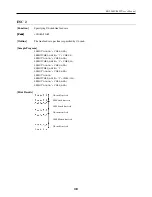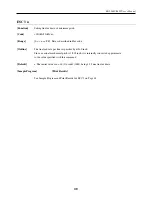
BD2-2880/2890 User’s Manual
50
ESC * m n1 n2 [ d ] k
Specifying the Bit Image Mode
<1B>H<2A>H<m><n1><n2> [ <d> ] k
{m= 0, 1, 32, 33 bit image mode (See the table below.)}
{0 =< n1 =< FF(Hex)}
{0 =< n2 =< 03(Hex)}
{0 =< d =< FF(Hex)}
{k = n1 + FF(Hex) n2
(m = 0, 1)
{k = (n1+ FF(Hex) n2) 3}
(m = 32, 33)
According to the number of dots specified in n1, n2, specify the bit image of mode n.
•
The No. of dots printed is divided by 256, whose quotient is taken as n2 and residual as n1.
•
The total no. of dots printed in the bit image is equal to n1 + (256 x n2).
•
When bit image data have been input in excess of dot position of one line (448 dots) ,
the excess data are discarded.
•
d is bit image data, the bits subject to printing are taken as "1" and those not as "0".
•
The bit image modes specified by m are shown as follows:
Vertical Direction
Horizontal Direction
m(Hex) Mode
No. of Dots
Dot Density
Dot Density
Max. No. of Dots
0
8-dot single density
8
67 DPI
101 DPI
192
1
8-dot double density
8
67 DPI
203 DPI
384
32
24-dot single density
24
203 DPI
101 DPI
192
33
24-dot double density
24
203 DPI
203 DPI
384
•
When the values set in m (bit image mode) are out of the above range, the data
following after n1 is processed as normal printing data.
•
After completion of bit image printing, printer returns to normal data processing mode.
[Example]
×
×
×
Single Density Double Density
Single Density Double Density
[Function]
[Code]
[Range]
[Outline]
[Caution]
















































